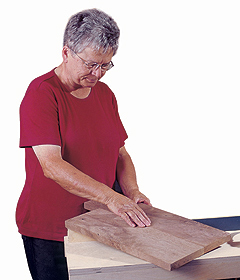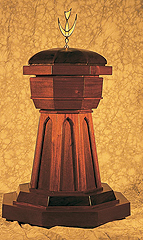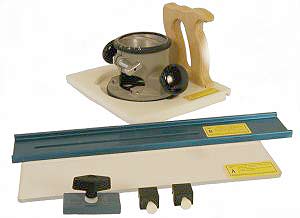
Carol Reed, also known as “The Router Lady,” is a highly accomplished woodworker, teacher, and author who grew up in an era where, as she says, “women did not do that sort of thing.”
“This year I became old enough to collect Social Security,” she confided to me, “but I am too proud to do so.” Pride, like her woodworking prowess, is something she has in great measure, and both were influenced in her early years.
“My interest in woodworking was ignited by my grandfather when I was seven years old,” she recounted. “We lived in Wisconsin. He was a dairy farmer who repaired furniture in the wintertime. He had a very modest and ill-kept collection of tools which, at the time, seemed adequate to me.”
“He put me to work one day making pine curlicues, and told me he needed a pail full. In retrospect, I now realize that I was getting in his hair, and he gave me something to keep me busy. He handed me a rusty plane and a pine board, and showed me how to make long, even, full-width shavings.
“But what he did next was most telling, and had a great influence on me. After I had filled the pail, he brought it into the house, gave it to my grandmother who cooked on a wood stove, and said ‘Here are some fire starters.’ In that one action, he gave my work validation.”
Her skills, and self-respect, grew from there. “I learned woodworking primarily from Popular Mechanics, the only magazine we got besides Saturday Evening Post.” She became a self-taught hobby woodworker, whose day job was as a technician for the phone company.
“I started off making custom rocking toys, such as rocking horses. My very first toy was a six foot three inch rocking giraffe, whose owner named him Geronimo.” That brought in more mundane jobs, like bookcases, tables, and so on.
After being laid off during the AT&T divestiture, she decided to become a professional woodworker, and started taking classes at Palomar Community College in San Marcos, California, near where she was living at the time. That not only sparked a career in woodworking, but resulted in her specializing in church furniture as well.

“In my last year at Palomar, I needed a culminating project, so I built all the chancel furniture at my church, including a pulpit, lectern, altar, and a twenty foot wall cross. The actual culminating project was only the altar, and the rest was gravy. It was a real job, but not a profitable one. They covered materials, and I donated the labor.
“As a result of that job, I was written up in a church magazine called the Lutheran Witness. That led to a call from a church in Kansas asking me to build their chancel furniture. I milled the wood in my shop in Ramona, California, loaded it on a truck, then finished and installed it in Kansas. It was a wonderful experience. This was a town of 1,100 people with no motel. Every Sunday, I went home with another family for a week. I sang in the choir, and lived with the church members. The ‘shop’ was a converted schoolhouse that had been built by the WPA, with huge windows and wood floors. It was a great shop, a great job, and a wonderful experience of community fellowship.”
Before long, she became known as an outstanding builder of chancel furniture. Her favorite piece, an octagonal, tapered barrel baptismal font that she made for a church in California, was featured in the late Pat Spielman’s router book. But a phone call once again sent her in a new direction.
“In 1996, I got a call from Palomar asking me to come back, this time to teach. I taught there for four and a half years, teaching part-time while still working as a woodworker. When I left, I went on the road to teach at woodworking shows, first going on the circuit with the now defunct American Woodworker Show, and later with Woodworks. These days, I mostly do home and garden shows.”

As a teacher, Carol saw the need for fixtures to make router tasks easier, and designed several. Word spread, and before long, she found herself making jigs instead of furniture. She bought a CNC machine, and switched to making and selling her inventions full time. Her flagship product was Router*Trac. Originally designed to rout dadoes, it was a straightedge guide that allowed any router or circular saw to cut in a straight line. The Big Foot, an oversized, see-through router base with a saw type handle, came next, and made it easier to control any router. “I always called it the intuitively correct woodworking handle.” There was also a trammel base for a router, and an outrigger to span cutouts.
A steadfast member of the woodworking community, Carol served on the board of directors of the San Diego Fine Woodworking Association, the largest woodworking guild in America, for five years, the last as the president. She was a founding member of the North County Woodworker’s Club, and has been a guest lecturer at a variety of woodworking guilds around the country, as well as teaching at Rockler Woodworking and Hardware stores in Seattle, Denver, Phoenix, and San Diego.
Last year, she closed her business and moved to Arizona in order to be close to, and to help with, her aging parents. The move forced her to sell her shop, and triggered a realization that it was time to focus on teaching and writing rather than manufacturing.
Her first book, called Router Joinery Workshop, was published by Sterling in 2003. She is currently working on a DVD on basic woodworking designed to be an introduction to woodworking for rank amateurs. That dovetails nicely with her home and garden show lectures, which are appropriately entitled “Woodworking at Home for Ordinary Folks.”
These days, she spends a good amount of time organizing and upgrading her current digs, while remaining very active in her church, where she teaches, preaches, and sings in the choir. In her spare time, she is learning Biblical Greek. “I find it very liberating that at the tender age of 62, I can still learn things like that.”
Liberating, perhaps, but not surprising for someone with Carol’s drive and energy. She seems to be quite capable of accomplishing anything she wants to do, and her own words explain why.
“Nothing happens until the ‘want to’ is in place. If you don’t want to, it ain’t gonna happen.”





